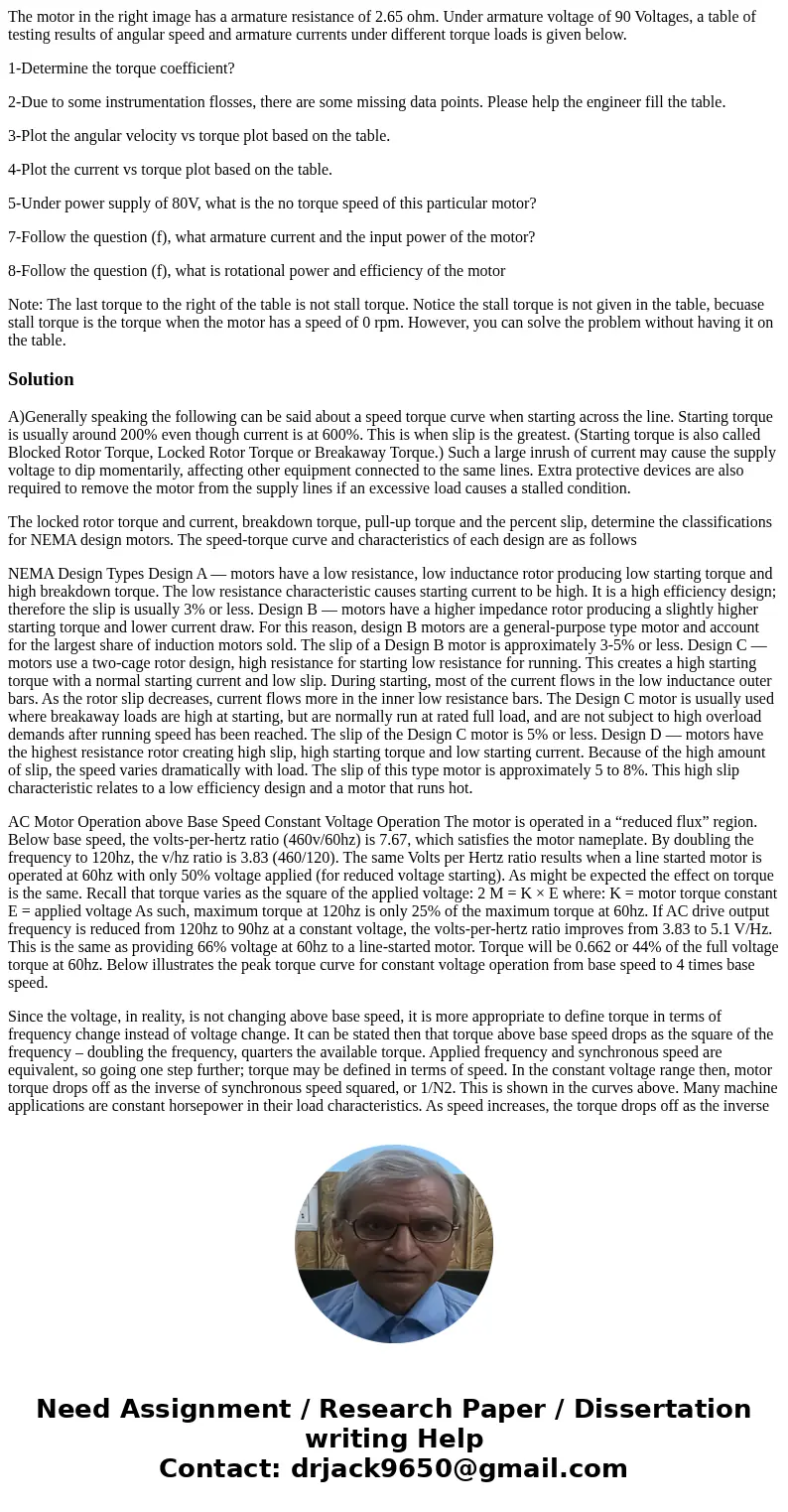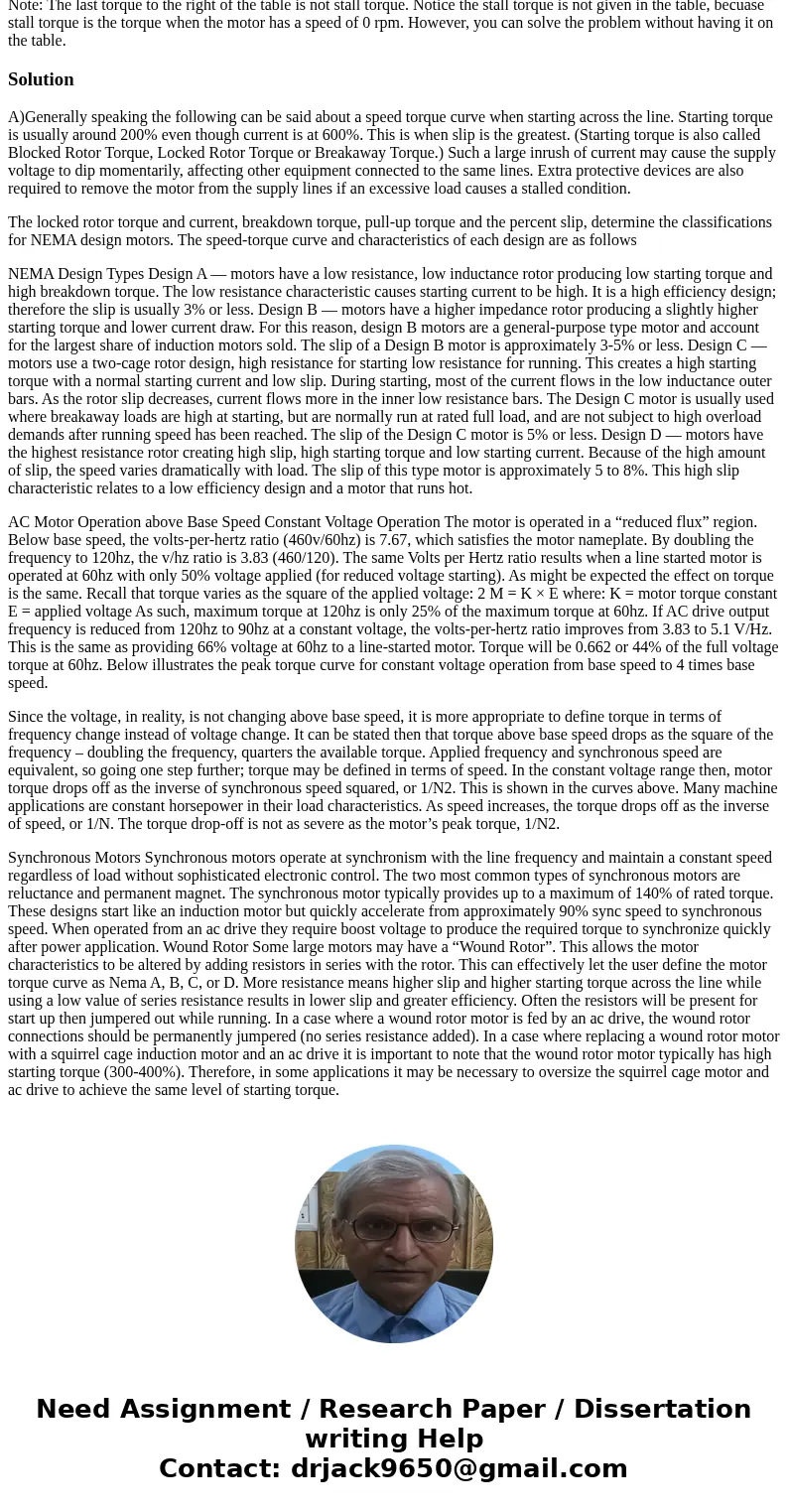The motor in the right image has a armature resistance of 26
The motor in the right image has a armature resistance of 2.65 ohm. Under armature voltage of 90 Voltages, a table of testing results of angular speed and armature currents under different torque loads is given below.
1-Determine the torque coefficient?
2-Due to some instrumentation flosses, there are some missing data points. Please help the engineer fill the table.
3-Plot the angular velocity vs torque plot based on the table.
4-Plot the current vs torque plot based on the table.
5-Under power supply of 80V, what is the no torque speed of this particular motor?
7-Follow the question (f), what armature current and the input power of the motor?
8-Follow the question (f), what is rotational power and efficiency of the motor
Note: The last torque to the right of the table is not stall torque. Notice the stall torque is not given in the table, becuase stall torque is the torque when the motor has a speed of 0 rpm. However, you can solve the problem without having it on the table.
Solution
A)Generally speaking the following can be said about a speed torque curve when starting across the line. Starting torque is usually around 200% even though current is at 600%. This is when slip is the greatest. (Starting torque is also called Blocked Rotor Torque, Locked Rotor Torque or Breakaway Torque.) Such a large inrush of current may cause the supply voltage to dip momentarily, affecting other equipment connected to the same lines. Extra protective devices are also required to remove the motor from the supply lines if an excessive load causes a stalled condition.
The locked rotor torque and current, breakdown torque, pull-up torque and the percent slip, determine the classifications for NEMA design motors. The speed-torque curve and characteristics of each design are as follows
NEMA Design Types Design A — motors have a low resistance, low inductance rotor producing low starting torque and high breakdown torque. The low resistance characteristic causes starting current to be high. It is a high efficiency design; therefore the slip is usually 3% or less. Design B — motors have a higher impedance rotor producing a slightly higher starting torque and lower current draw. For this reason, design B motors are a general-purpose type motor and account for the largest share of induction motors sold. The slip of a Design B motor is approximately 3-5% or less. Design C — motors use a two-cage rotor design, high resistance for starting low resistance for running. This creates a high starting torque with a normal starting current and low slip. During starting, most of the current flows in the low inductance outer bars. As the rotor slip decreases, current flows more in the inner low resistance bars. The Design C motor is usually used where breakaway loads are high at starting, but are normally run at rated full load, and are not subject to high overload demands after running speed has been reached. The slip of the Design C motor is 5% or less. Design D — motors have the highest resistance rotor creating high slip, high starting torque and low starting current. Because of the high amount of slip, the speed varies dramatically with load. The slip of this type motor is approximately 5 to 8%. This high slip characteristic relates to a low efficiency design and a motor that runs hot.
AC Motor Operation above Base Speed Constant Voltage Operation The motor is operated in a “reduced flux” region. Below base speed, the volts-per-hertz ratio (460v/60hz) is 7.67, which satisfies the motor nameplate. By doubling the frequency to 120hz, the v/hz ratio is 3.83 (460/120). The same Volts per Hertz ratio results when a line started motor is operated at 60hz with only 50% voltage applied (for reduced voltage starting). As might be expected the effect on torque is the same. Recall that torque varies as the square of the applied voltage: 2 M = K × E where: K = motor torque constant E = applied voltage As such, maximum torque at 120hz is only 25% of the maximum torque at 60hz. If AC drive output frequency is reduced from 120hz to 90hz at a constant voltage, the volts-per-hertz ratio improves from 3.83 to 5.1 V/Hz. This is the same as providing 66% voltage at 60hz to a line-started motor. Torque will be 0.662 or 44% of the full voltage torque at 60hz. Below illustrates the peak torque curve for constant voltage operation from base speed to 4 times base speed.
Since the voltage, in reality, is not changing above base speed, it is more appropriate to define torque in terms of frequency change instead of voltage change. It can be stated then that torque above base speed drops as the square of the frequency – doubling the frequency, quarters the available torque. Applied frequency and synchronous speed are equivalent, so going one step further; torque may be defined in terms of speed. In the constant voltage range then, motor torque drops off as the inverse of synchronous speed squared, or 1/N2. This is shown in the curves above. Many machine applications are constant horsepower in their load characteristics. As speed increases, the torque drops off as the inverse of speed, or 1/N. The torque drop-off is not as severe as the motor’s peak torque, 1/N2.
Synchronous Motors Synchronous motors operate at synchronism with the line frequency and maintain a constant speed regardless of load without sophisticated electronic control. The two most common types of synchronous motors are reluctance and permanent magnet. The synchronous motor typically provides up to a maximum of 140% of rated torque. These designs start like an induction motor but quickly accelerate from approximately 90% sync speed to synchronous speed. When operated from an ac drive they require boost voltage to produce the required torque to synchronize quickly after power application. Wound Rotor Some large motors may have a “Wound Rotor”. This allows the motor characteristics to be altered by adding resistors in series with the rotor. This can effectively let the user define the motor torque curve as Nema A, B, C, or D. More resistance means higher slip and higher starting torque across the line while using a low value of series resistance results in lower slip and greater efficiency. Often the resistors will be present for start up then jumpered out while running. In a case where a wound rotor motor is fed by an ac drive, the wound rotor connections should be permanently jumpered (no series resistance added). In a case where replacing a wound rotor motor with a squirrel cage induction motor and an ac drive it is important to note that the wound rotor motor typically has high starting torque (300-400%). Therefore, in some applications it may be necessary to oversize the squirrel cage motor and ac drive to achieve the same level of starting torque.


 Homework Sourse
Homework Sourse